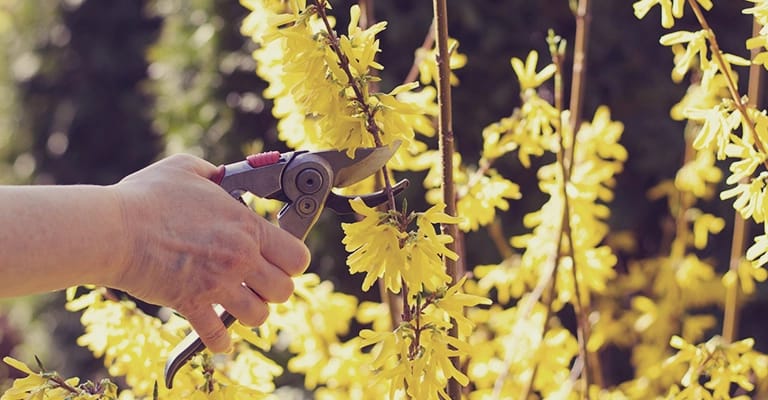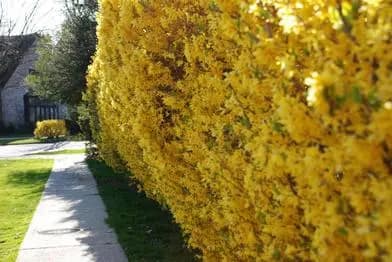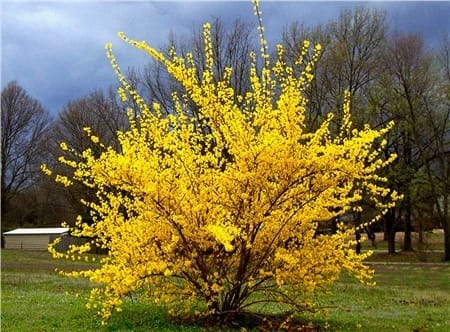Forsythia is a beautiful and vibrant flowering shrub that heralds the arrival of spring with its bright yellow blooms. If you’re looking to add a burst of color to your garden, planting forsythia is an excellent choice. This comprehensive guide will walk you through everything you need to know about forsythia plant care, including how to plant forsythia, care for it, and use it to create stunning hedges.
What is Forsythia?
Forsythia is a deciduous shrub known for its stunning yellow flowers that bloom in early spring. Native to Asia and Eastern Europe, forsythia is a popular ornamental plant in gardens and landscapes due to its hardiness and vibrant display of flowers.
How to Plant Forsythia
Planting forsythia is a straightforward process that can be done in either spring or fall. Here’s a step-by-step guide to get you started:
- Choose the Right Spot: Forsythia thrives in full sun but can tolerate partial shade. For best results, plant forsythia in a location that receives at least six hours of sunlight daily.
- Prepare the Soil: Forsythia prefers well-drained soil with a pH level of 6.0 to 7.0. Amend the soil with organic matter if necessary to improve drainage and fertility.
- Dig the Hole: Dig a hole that is twice as wide and just as deep as the root ball of the plant.
- Plant the Forsythia: Place the root ball in the hole and backfill with soil, making sure to firm the soil around the base of the plant. Water thoroughly after planting.
Forsythia Plant Care
Proper care is essential to ensure your forsythia thrives. Here are some tips on forsythia plant care:
- Watering: Water newly planted forsythia regularly to keep the soil moist but not waterlogged. Once established, forsythia is drought-tolerant and requires less frequent watering.
- Mulching: Apply a layer of mulch around the base of the plant to retain moisture and suppress weeds.
- Fertilizing: Forsythia generally does not require heavy feeding. However, applying a balanced fertilizer in early spring can promote healthy growth and flowering.
- Pruning: Prune forsythia after flowering to maintain its shape and encourage new growth. Remove any dead or damaged branches to keep the plant healthy.
Planting Forsythia Cuttings

Propagating forsythia from cuttings is an economical way to increase your plant stock. Here’s how to do it:
- Select Healthy Cuttings: Take cuttings from healthy, non-flowering stems in late spring or early summer. Each cutting should be about 6-8 inches long.
- Prepare the Cuttings: Remove the lower leaves, leaving only the top 2-3 leaves on each cutting.
- Plant the Cuttings: Dip the cut end of each cutting in rooting hormone and plant them in a pot filled with a well-draining potting mix. Water thoroughly and cover with a plastic bag to create a humid environment.
- Transplant: Once the cuttings have rooted, usually within a few weeks, transplant them into the garden or larger pots.
Forsythia Growing Zones and Conditions
Forsythia is hardy in USDA zones 5-8. It prefers full sun to partial shade and can grow in a variety of soil types, provided they are well-drained. Forsythia is also tolerant of urban pollution, making it an ideal choice for city gardens.
Can Forsythia Grow in Shade?
While forsythia thrives in full sun, it can tolerate partial shade. However, planting forsythia in too much shade may result in fewer flowers and leggy growth. For best results, choose a location that receives plenty of sunlight.
Creating a Forsythia Hedge

Planting forsythia hedge is an excellent way to create a natural privacy screen or border in your garden. Here’s how to do it:
- Plan Your Hedge: Determine the length of your hedge and the number of plants needed. Space forsythia plants about 3-4 feet apart for a dense hedge.
- Planting: Follow the same planting steps mentioned earlier, ensuring each plant is evenly spaced.
- Maintenance: Regularly prune your hedge to maintain its shape and promote healthy growth.
Planting Forsythia Spacing
Proper spacing is crucial when planting forsythia to ensure each plant has enough room to grow. Space individual plants about 3-4 feet apart to allow for adequate air circulation and growth.
Different Varieties of Forsythia
There are several varieties of Forsythia, each with its unique features. Some popular ones include:
- Forsythia x intermedia: A hybrid variety known for its hardiness and prolific blooming.
- Forsythia suspensa: Known for its weeping branches and suitability for ground cover.
- Forsythia viridissima: Has greenish-yellow flowers and is highly resistant to disease.
Choosing the Right Forsythia
Selecting the Best Variety for Your Garden
When choosing Forsythia for your garden, consider factors like climate, soil type, and the size of the mature plant. Some varieties are more suited to specific conditions than others.
Where to Buy Forsythia Plants
You can purchase Forsythia plants from local nurseries, garden centers, or online retailers. Ensure you buy healthy plants from reputable sources to avoid diseases and pests.
When to Plant Forsythia
Ideal Planting Seasons
The best time to plant Forsythia is in early spring or late fall when the plant is dormant. This gives the roots time to establish before the growing season begins.
Climate Considerations
Forsythia thrives in USDA hardiness zones 5 to 8. It prefers full sun to partial shade and can tolerate a range of soil conditions, though it performs best in well-drained soil.
Planting Forsythia
Step-by-Step Planting Instructions
- Dig a Hole: Dig a hole twice as wide and as deep as the root ball of the Forsythia plant.
- Position the Plant: Place the plant in the hole, ensuring the top of the root ball is level with the surrounding soil.
- Backfill the Hole: Fill the hole with soil, gently tamping it down to eliminate air pockets.
- Water Thoroughly: Water the plant well to help settle the soil and establish the roots.
Proper Plant Spacing
Space Forsythia plants about 4 to 6 feet apart to allow for proper air circulation and room for growth.
Watering Forsythia
Watering Needs and Schedule
Forsythia needs regular watering, especially during the first year after planting. Water deeply once a week, allowing the soil to dry out slightly between waterings.
Signs of Overwatering and Underwatering
Overwatering can lead to root rot, while underwatering can cause the plant to wilt. Ensure the soil is moist but not soggy, and adjust your watering schedule based on weather conditions.
Fertilizing Forsythia
Best Fertilizers for Forsythia
Use a balanced, slow-release fertilizer with equal parts nitrogen, phosphorus, and potassium. An all-purpose garden fertilizer (10-10-10) works well.
How and When to Fertilize
Fertilize Forsythia in early spring before new growth starts. Follow the manufacturer’s instructions for application rates and methods.
Pruning Forsythia
Why Pruning is Important
Pruning helps maintain the shape of the Forsythia, encourages new growth, and improves flowering. It also removes dead or diseased wood, promoting overall plant health.
Pruning Techniques and Timing
Prune Forsythia immediately after flowering. Cut back old wood to ground level and thin out crowded branches. This encourages new growth and more blooms the following year.
Pest and Disease Management
Common Pests and Diseases
Forsythia is relatively pest-free but can be affected by aphids, scale, and spider mites. Diseases like leaf spot and twig blight can also occur.
Natural and Chemical Solutions
Use insecticidal soap or neem oil to control pests. For diseases, prune affected areas and ensure good air circulation. Fungicides may be necessary for severe infections.
Companion Planting
Best Companion Plants for Forsythia
Companion plants for Forsythia include daffodils, tulips, and other spring-blooming bulbs. These plants create a colorful display when planted together.
Plants to Avoid
Avoid planting Forsythia near plants that require constant moisture, as Forsythia prefers well-drained soil and may not thrive in overly wet conditions.
Forsythia in Landscaping
Creative Landscaping Ideas
Use Forsythia as a focal point in your garden, plant it in mixed borders, or use it to create a stunning hedge. Its early spring flowers make it an excellent choice for adding seasonal interest.
Forsythia in Hedges and Borders
Forsythia makes a great hedge due to its dense growth habit. Plant it along property lines or use it to define garden spaces.
Propagating Forsythia
Methods of Propagation
Forsythia can be propagated by cuttings, layering, or division. Softwood cuttings taken in late spring or early summer root easily.
Tips for Successful Propagation
Use rooting hormone to improve success rates for cuttings. Keep the soil moist and provide bright, indirect light until new plants are established.
Seasonal Care
Spring and Summer Care
In spring, apply mulch around the base of the plant to conserve moisture and suppress weeds. Water regularly and fertilize as needed.
Fall and Winter Care
In fall, remove fallen leaves and debris to prevent disease. In winter, protect young plants from extreme cold with a layer of mulch or burlap.
Frequently Asked Questions about Forsythia
How to plant forsythia?
- Choose a sunny spot, prepare the soil, dig a hole twice as wide as the root ball, plant the forsythia, and water thoroughly.
How to plant forsythia cuttings?
- Take 6-8 inch cuttings, remove lower leaves, dip in rooting hormone, plant in well-draining potting mix, and cover with a plastic bag until rooted.
Can forsythia grow in shade?
- Forsythia can tolerate partial shade but will have fewer flowers and leggy growth compared to those planted in full sun.
Forsythia planting zone?
- Forsythia is hardy in USDA zones 5-8.
When to plant forsythia bushes?
- Plant forsythia in either spring or fall for best results.
Forsythia growing conditions?
- Forsythia prefers full sun, well-drained soil, and can tolerate a variety of soil types and urban pollution.
Submit your review | |

